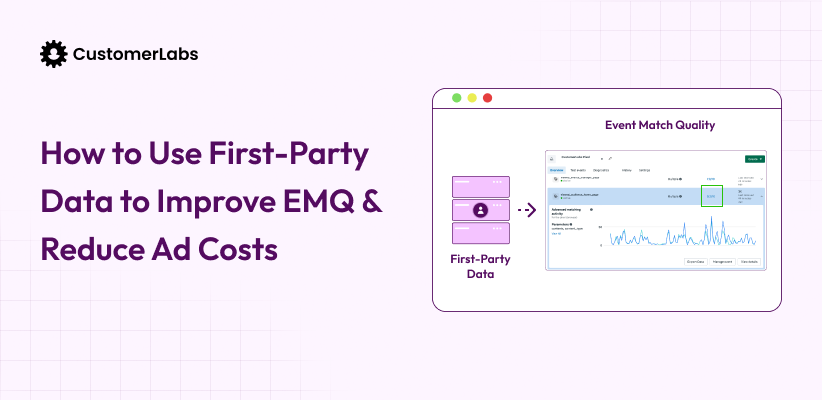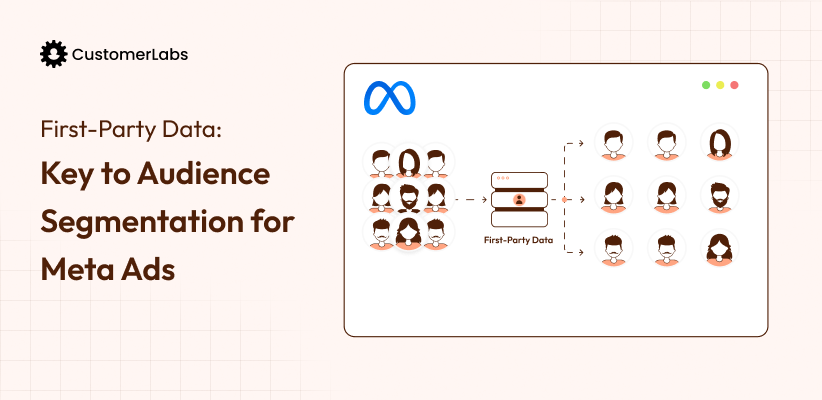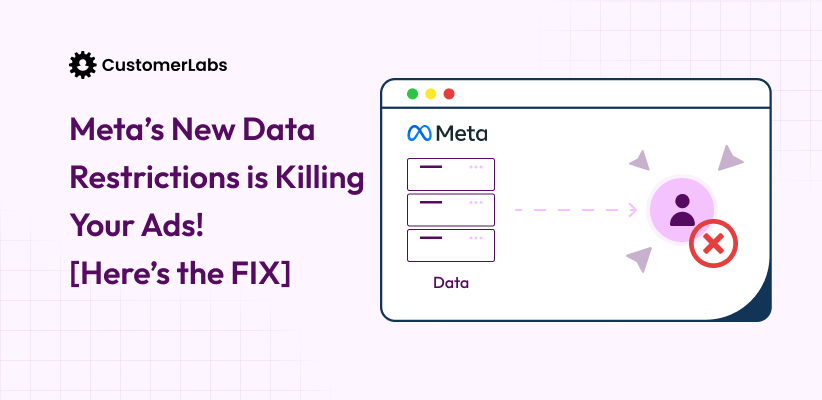First-party data isn’t just the future—it’s the edge top brands are using right now to outsmart rising ad costs, provide personalization like never before, and build unshakable customer loyalty.
No more guessing games with cold audiences. No more relying on platforms that limit your visibility.
With the data you already own, you can create campaigns that actually perform.
This isn’t just a shift—it’s a serious competitive advantage
Want to know what makes it so powerful? Let’s dive into the real benefits of first-party data —and by the end, you’ll know exactly how to start leveraging first-party data to experience these benefits for yourself.
Benefits of first-party data
Control over data
One of the biggest benefits of first-party data is simple but too powerful: you control what you collect, store, and share.
Unlike relying on third-party platforms that dictate what data you can access and how it’s used, first-party data puts you in the driver’s seat. This control becomes especially critical when you’re running paid campaigns on platforms like Meta. With first-party data, you decide exactly what data to send back to Meta for campaign optimization—whether that’s purchase events, lead submissions, or even behavioral signals.
Now, this level of control matters even more in sensitive industries like health and wellness, where marketers are constantly walking a fine line between personalization and privacy. If you’re handling PHI (Protected Health Information) or direct PII (Personally Identifiable Information), you can’t afford to play fast and loose with compliance.
First-party data allows you to filter and forward only the necessary signals—nothing more, nothing less—keeping you compliant with the privacy standards while still feeding your ad platforms with high-quality, consented signals.
But control starts at collection. With Consent Mode v2 on the field, you can now collect data based on user choices, respecting cookie banners, opt-ins, and regional privacy rules (like GDPR in the EU or CCPA in the U.S.). This means even if a user declines marketing cookies, you can still collect certain consented behavioral signals to maintain campaign performance—without compromising trust.
Accuracy and Reliability
Let’s face it—when you’re spending a serious budget on ads, email campaigns, or product personalization, bad data can cost you more than just clicks. That’s where first-party data benefits you. It’s the most accurate, real-time, and reliable source of customer insight you’ll ever have—because it comes directly from the source: your users.
With first-party data, you’re not relying on outdated third-party cookies or rented audience segments. Because you are collecting first-party data in real-time, which means you are working with real-time behavioral signals—what your users clicked, browsed, bought, or abandoned—as it happens. This level of real-time accuracy helps you react faster, make smarter campaign decisions, and deliver messages that are actually relevant to your users’ intent right now.
It also means higher data fidelity. You’re not getting modeled assumptions or stitched-together identifiers. You’re working with clean, verified, event-level data that’s tied directly to your owned channels—your website, app, or CRM.
The result? Less guesswork. More precision. And better performance.
In short, when your data is accurate, timely, and permission-based, every decision you make gets sharper—and every dollar you spend works harder.

Enhanced Personalization
Personalization isn’t just a buzzword anymore—it’s the baseline. You have to advertise the product in your customer’s love language 😅 (you know what I mean, the way they understand or resonate with)
But here’s the catch: Thinking of providing personalization without the right data is like trying to write a love letter to a stranger—you’re guessing their story, and it’s bound to miss the mark.
With first-party data, you can provide personalization effortlessly. Because this data comes directly from your users—what they viewed, clicked, purchased, subscribed to, or abandoned—it enables you with crucial insights about your customers/users. With this enormous data, you can send hyper-relevant messaging at every touchpoint.
First-party data in place, you’re not just guessing what your audience might like—you know what they’re interested in, and you can act on it instantly.
Whether it’s a dynamic product ad on Meta or a personalized search ad, first-party data benefits you by letting you retarget users based on real interactions with your brand. For example, if someone browsed immunity supplements or skin care treatments on your website, you can show them exactly that—without wasting impressions on irrelevant items.
If you are a health and wellness brand and have a hard time facing event restrictions, or want to bridge the gap TOFU tracking gap and improve attribution or your ROAS is tanking, you know what to do. Click here.
Back to the topic. You can deliver timely reminder with the help of first-party data. How? If a user abandons their cart, you can set automatic triggers like an email or SMS at the right moment with a tailored message or offer.
If they downloaded an ebook or attended a webinar? You can follow up with the next best action, not a generic drip sequence. First-party data powers event-based automations that feel like one-to-one conversations.
With clean, unified data, your messaging can stay consistent from your ads to your emails to your website experience. You can speak to different segments—loyal customers vs. first-time visitors—without overlapping or repeating messages. This not only improves conversion rates but also builds trust and relevance across the entire customer journey.
And because it’s all powered by data you own, there’s no lag, no limitations, and no middlemen. You’re free to personalize deeply, ethically, and effectively—at scale.
Also read on: How to use first-party data for better conversion and retention?
Compliance with Privacy Regulations
With privacy regulations tightening across the globe, marketers like you can no longer afford to treat data compliance as an afterthought. The good news? First-party data benefits by being inherently privacy-forward—making it the most future-proof strategy in your marketing stack.
Whether you’re dealing with GDPR in Europe, CCPA in California, HIPAA in healthcare, or the upcoming DPDPA in India, first-party data gives you a clear compliance advantage.
Why? Because it’s data collected directly from your users with their knowledge and consent. No hidden trackers, no vague third-party aggregators—just transparent, trust-based data collection.
When you own the data relationship, you also own the responsibility—and that’s a good thing. It means:
- You are transparent with your users
- You know what was collected
- You know why it was collected
- You know where it’s stored
And most importantly— it’s your data and you are not breaking any laws by using it.
This makes everything from opt-out mechanisms to consent records traceable and manageable—without needing to chase down third-party vendors.
You can collect only what’s allowed, store it responsibly, and activate it in ways that align with both legal and ethical standards. And since the data never leaves your ecosystem without purpose, you significantly reduce the risk of non-compliance or costly fines.
But beyond meeting today’s laws, first-party data is built for the future of privacy. As browsers phase out third-party cookies and regulators tighten the screws on data brokers, brands that invest in first-party strategies won’t just survive—they’ll lead.
You won’t be caught off guard. You won’t be scrambling to rebuild audience strategies. With first-party data, you’re already aligned with where privacy is headed—secure, consented, and user-first.
Better Audience Segmentation
Not all your visitors are the same—and they shouldn’t be treated the same as well. One of the most powerful benefits of first-party data is the ability to create highly segmented audiences based on real, high-intent behaviors. This isn’t just segmentation based on demographics—this is behavioral precision.
With first-party data, you can build segments such as frequent buyers, cart abandons, users who viewed but didn’t buy, added to cart but didn’t buy, checkout made but didn’t pay, wish listed a product. More and more. The list goes on and on.
When it comes to segmentation, it’s up to you. You can build multiple segments as precise as you want, you just need to a marketer’s mind.
These aren’t just vanity segments—they’re actionable, revenue-generating segments that can be activated across Meta, Google Ads, email, and SMS platforms. And because the data is fresh, consented, and event-based, you can setup retargeting campaigns with personalized relevant messaging, trigger automations, build lookalike audiences, or suppress churn-prone users with incredible accuracy.
The result? More relevant messaging, higher engagement, and better ROI—without waste or overlap.
With this level of segmentation, your marketing no longer feels like mass broadcasting—it feels like precision targeting at scale.
Cost efficiency
Let me be frank with you. For your marketing efforts to pay off, you need to pay off for your marketing efforts. Marketing budgets aren’t unlimited. Every dollar counts. You will have to answer every penny that you spend on that ad that you are running right now.
First-party data benefits you by helping you spend smarter, not harder, by eliminating waste and boosting performance across every channel.
Because you’re targeting based on real user actions—not inferred interest—you dramatically increase ad relevance, which leads to:
- Higher CTRs
- Lower CPAs
- Better ROAS
You are no longer throwing ad spend at cold, lookalike audiences or third-party lists that may or may not convert. Instead, you’re investing in high-intent, known audiences—cart abandoners, repeat visitors, or past purchasers—people far more likely to take action.
With first-party data,
- You’re building your own marketing asset—a customer list that grows in value over time, unlike third-party audiences come with recurring costs.
- First-party data allows you to feed cleaner signals into these platforms like Meta and Google—boosting your EMQ score and dropping your CPC.
- And many more…
The result? More purchases, higher revenue, and lower acquisition costs—all while future-proofing your strategy.
If you’re serious about profitable growth, first-party data isn’t something that you should compromise on.
Also Read on: How to activate anonymous website visitors using first-party data in Meta Ads
Building Customer Trust and Loyalty
Your customers won’t buy from you if they lack trust on you.
In a world of spammy ads and data breaches, trust has become the new currency—and first-party data is the way to earn it.
When you collect data directly from your customers with transparency and consent, you’re not just getting access—you’re building a mutual value exchange. Your customers know what they’re sharing, and they see the value in return: better recommendations, relevant offers, smoother experiences.
(Trust me, your customers love when you provide them with those personalized recommendations, and research says they’ll probably buy from you.)
This foundation of trust leads to:
Higher lifetime value: Trust drives retention. Customers who feel seen and respected stick around longer, buy more often, and become brand advocates.
More data shared voluntarily: When people trust your brand, they’re more likely to share preferences, feedback, and even sensitive data (especially in health, wellness, and finance)—because they know it’s being used responsibly.
Emotional loyalty: Personalization powered by first-party data benefits you, not just with boosting conversions— but it also strengthens emotional connection. You’re not just selling a product—you’re curating an experience that feels tailor-made.
Think about it: brands like Amazon or Netflix didn’t earn loyalty with discounts alone—they did it by knowing their customers better than anyone else.
First-party data allows your brand to do the same—ethically, respectfully, and effectively.
In the long run, loyalty built on trust isn’t just profitable—it’s unshakeable.
When it comes to first-party, the benefits can be infinite. And if I have to write about all the benefits, this blog wouldn’t be enough.
And it depends on you, the marketer, on how strategically you plan to use your own customer data to reap countless benefits from it.
Let’s move into some use cases of first-party data as a starter kit for you.

Real-World Use Cases of First-Party Data
First-party data isn’t just about owning your customer information—it’s about putting it to work. When used strategically, it can transform how you run campaigns, personalize outreach, and ultimately scale your growth.
Here are some powerful, real-world use cases:
1. Granular Audience Segmentation
Create highly specific audience segments based on real actions like:
- Frequent buyers: Target loyal customers with exclusive drops, bundles, or early access.
- Cart abandons: Re-engage them with urgency-based messaging or a limited-time offer.
- Viewed but didn’t add to cart: Nudge them with product highlights, social proof, or reviews.
- Added to cart but didn’t checkout: Highlight payment options, shipping deadlines, or scarcity.
- Wishlisted but didn’t purchase: Perfect for price-drop alerts or personalized discounts.
- Product category interest: Segment based on category (e.g., hair care vs. immunity) and tailor campaigns accordingly.
- Repeated visitors in the last 7 days: High interest signals—ideal for retargeting with deeper offers or product education.
- Spent >30 seconds on a product page: Indicates product consideration; ideal for retargeting with benefit-focused creatives.
These segments help you tailor messaging, improve ROAS, and reduce ad waste.
2. Track Custom Events That Reflect Your Funnel
Track and send custom events based on your unique funnel stages—like lead qualified, webinar attended, add-to-cart with discount code, purchase based on category and AOVs, new purchases, repeat purchases, etc.
Custom events give you finer control over optimization and help ad platforms learn faster and perform better.
3. Navigating Health & Wellness Restrictions
In sensitive industries like healthcare and wellness, you can’t send PHI (Protected Health Information) or direct PII to Meta. As discussed in the previous section, First-party data gives you control, which lets you collect data with consent and process it securely before sending it to ad platforms.
You can choose to send only the necessary, privacy-compliant data for ad optimization
This ensures compliance with HIPAA, GDPR, and Meta’s own ad restrictions.
4. Value-Based Bidding with Lead Stage Values
While collecting first-party data, you gather every touchpoint, be it crucial or not, you have it all. By analyzing the first-party data, you can pinpoint every stage of the customer that pushed them towards conversion and every step that gave you the revenue.
With first-party data, you can assign numeric values to leads based on the lead stages such as booked a call, purchased a product, viewed a product and assign values and send these values back to ad platforms (like Meta or Google) to train their algorithms to optimize for high-value leads. This improves lead quality and revenue.
5. Training ASC + Performance Max Algorithms
Today’s ad platforms rely heavily on AI and machine learning. To get the most out of them efficient, you have got to feeding them rich, high-intent first-party data. By doing so, you can train Meta’s ASC and Google’s PMax models faster with crucial touchpoints, which helps target relevant audiences.
Additionally, it also reduces burn during learning phase. The better the input, the better the output—your data is the algorithm’s fuel.
Also read on: How to Use First-Party Data to Reduce RTO for Shopify
6. Mapping the Complete Customer Journey
First-party data helps you stitch together every touchpoint—ads, website, CRM, email, SMS—so you can. See which channels drive first and last touchpoints. Understand what drove the users towards the purchase, identify the drop-off points.
This visibility helps you optimize across the full funnel—not just isolated channels.
Now let me tell you how you can get started with first-party data that you have.
Steps to Start Leveraging First-Party Data
Now that you know the importance first-party data and the benefits that it can unlock—better ROAS, tighter segmentation, privacy-compliant growth—the question is: how can you start getting these results for your brand? And here’s how you can:
1. Audit Your Touchpoints
Map all the places where customer interactions happen such as website form fills
checkout pages, mobile apps, POS systems, email interactions, offline conversions’ data, in-store interactions, etc., This helps you understand what data you’re already collecting—and what you’re missing.
2. Get Clear, Consent-Backed Data
With privacy laws rolling out and restrictions tightening, ensure your data collection is transparent and compliant with privacy laws such as GDPR, CCPA, HIPPA, DPDPA. Use banners, checkboxes, and preference centers to secure trust and stay future-ready.
3. Invest in Infrastructure
You’ll need the right stack to make your first-party data actionable. A 1PD Ops Platform to track, collect, store, unify, enrich, and send clean, server-side events for better ad performance. CRM integrations to personalize customer journeys
4. Build Segments and Journeys
Once your data is flowing, segment based on behavior (e.g., cart abandoners, engaged non-buyers). And create triggers and setup marketing campaigns to tailor personalization to specific segments through email, ads, and SMS.
5. Test, Iterate, and Scale
Now track results, optimize messaging, and gradually expand your strategy. Using 1PD Analytics, you can measure the performance of your entire marketing efforts. See which channel, campaigns, ad, content is clearly working or bringing the conversion that is required.
You can also visually see which audience segment or event data has brought in. Marketing is all about experimenting, the only thing that matters is you watch and pause at the right time when it’s not working for you.
Let’s wrap this up.
Conclusion
First-party data is your path to smarter marketing, stronger customer relationships, and sustainable growth. From controlling what data gets shared with platforms to delivering hyper-personalized experiences and staying fully compliant with global privacy laws, the advantages are clear: brands that prioritize first-party data are already winning.
The truth is, most brands have first-party data. What they lack is the ability to activate it—across Meta Ads, Google, email, and beyond.
That’s where a First-Party Data Operations (1PD Ops) Platform comes in. It connects your customer data—from your site, CRM, or offline sources—and sends it to ad platforms in real-time, with consent and control.
The next step? It’s about action.
Because those benefits of first-party data that we talked about—better ROAS, higher customer lifetime value, improved trust—they don’t just happen. You build them, one signal, one segment, and one journey at a time.
So…
Are you ready to make your data work harder and smarter for your brand? Book a Demo now, let’s talk first-party data.






